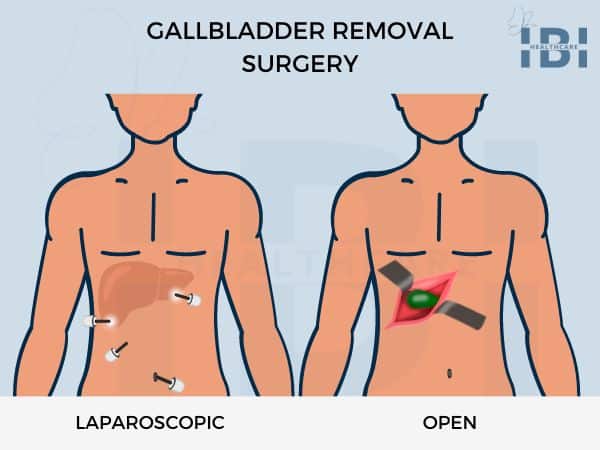Laparoscopic Gallbladder Removal Surgery
Specifically, surgeons in the United States commonly perform Laparoscopic Gallbladder Removal Surgery or Laparoscopic Cholecystectomy.
Additionally, at IBI Healthcare Institute, we understand that our patients don’t have time for lengthy recoveries and drawn-out procedures. Furthermore, we offer outpatient procedures for FiLaC® Anal Fistulas, SiLaC® Pilonidal Cysts, and Gallbladder Removal procedures.
Historically, surgeons performed this surgery through a 4-6” long incision for gallbladder removal. But today, unless there are demanding circumstances. The majority of surgeons perform it laparoscopically through a small incision near the belly button. Most often, people refer to it as laparoscopic gallbladder removal due to the technique used.
What is a Gallbladder and what does it do?
Moreover, the gallbladder resembles the shape of a pear. It’s worth noting that it lies just below the liver on the right-hand side. Especially, the liver produces a digestive fluid called bile, and the gallbladder’s primary function is to store and concentrate it.
Then, it releases this fluid into the digestive system through narrow tubular channels called bile ducts. Whereas, it breaks down and absorbs fat from food. Usually, patients do not experience any digestive disturbances due to the removal of their gallbladder.
How do Gallbladder Problems arise?
On the other hand, gallstones form from cholesterol and bile and become small hard deposits that form in the gallbladder. However, they can be as tiny as a grain of sand or as big as a golf ball. In addition, they are generally the reason behind gallbladder problems.
Hence, we do not yet know why some individuals are more prone to experience gallstones. But women tend to have a higher instance. Although, the risks of developing gallstones increase for women. Even so, those Who have had prior pregnancies, are over 40 years old or are individuals with heavier body weight.

Although, it is not unusual for an individual to have a family history of gallstones. However, unfortunately, experts do not know of an exact way to prevent gallstones from occurring. Even so, when gallstones occur, they prevent bile from flowing out of the gallbladder which causes it to swell up. Thus, it can create a fever, vomiting, sharp abdominal pain, and sometimes jaundice can occur and the skin turns yellow.
How do Doctors Diagnose and Treat Gallbladder Problems?
Diagnose
- The most common test used to identify gallstones is an ultrasound.
- Occasionally, doctors may use other X-ray tests. Such as a CT scan or a gallbladder radionuclide scan to investigate gallbladder disease.
- You can temporarily manage some of the symptoms, but gallstones do not go away on their own.
Treatments
- Reducing the intake of fat may help alleviate gallstone symptoms short-term.
- Treatments that attempt to dissolve or break up gallstones are not very effective. Thus, the gallstones will return unless surgeons surgically remove the gallbladder.
What are the Advantages of Laparoscopic Gallbladder Removal?
- Surgeons perform laparoscopic gallbladder removal through three or four small incisions. Unlike open gallbladder surgery, which requires five to seven-inch incisions.
- Patients usually experience minimal post-operative pain after a laparoscopic procedure.
- Laparoscopic gallbladder patients normally experience a shorter and easier recovery than patients who undergo open gallbladder surgery.
- Most patients do not require an overnight hospital stay and can return home the same day.

Who is a Candidate for Laparoscopic Gallbladder Removal?
Indeed, patients who have advanced gallbladder disease or prior abdominal surgery may not be suitable candidates for gallbladder surgery. Without a doubt, the best way to determine candidacy. Through a comprehensive evaluation by a qualified surgeon.
What Preparations Do You Need Before Gallbladder Removal Surgery?
Unquestionably, your doctor will provide you with detailed instructions to prepare you for your gallbladder removal. Surgeons’ requirements may vary as each patient is unique but some of these prerequisites for surgery may include:
Preoperative testing includes blood work and a full health evaluation. Additionally, an EKG depending on your age and health status.
After you and your surgeon discuss the potential risks and benefits of the operation. Your surgeon will ask you to sign a written consent form for surgery.
Surgeon may ask you to shower the night before with antibiotic soap.
Because you will be undergoing surgery with general anesthesia. You may not be able to eat or drink anything after midnight the night before your surgery.
Your surgeon will instruct you regarding any necessary medications you routinely take.
You will need to stop taking certain prescription drugs, anti-inflammatory medications, and herbal supplements. Such as Vitamin E or St John’s Wort for at least two weeks before surgery.
You will need to quit smoking and arrange for any help you may need at home during your recovery.
How do Surgeons Perform Laparoscopic Gallbladder Removal?
Therefore, the steps involved in performing a male or female gallbladder surgery are generally the same. But there is a difference in the level of difficulty between genders. Typically, it is more difficult to remove a man’s gallbladder. Because men tend to have more anatomic anomalies and a higher degree of fibrosis.
General Steps of Gallbladder Removal Surgery
The medical team administers anesthesia to ensure that the patient is asleep during the procedure.
Surgeons create four small incisions in the abdomen.
They inserts a laparoscopy into the abdomen through one of the incisions. It’s a hollow tube-like instrument with an attached video camera.
Using the real-time video as a guide. Then the surgeon inserts other surgical tools through the other abdominal incisions to remove the gallbladder.
They may choose to perform an imaging test before closing the incisions. However, ensuring that there are no gallstone obstructions or bile duct issues.
The surgeon closes the incisions. Then move the patients to a recovery room for observation. Afterward, either discharge or transfer them to a hospital room for a stay of between one and three days.
What if Surgeons Cannot Remove the Gallbladder Laparoscopically?
Albeit, in a very small number of cases. The surgeon may have to convert a laparoscopic procedure into an open procedure. Besides this, it can happen if inflammation or dense scarring affects the gallbladder. Hence, it may result from previous abdominal surgery.
Nonetheless, if the surgeon experiences visibility issues or bleeding problems during a laparoscopic procedure. Subsequently, they may find it necessary to convert to open gallbladder surgery. Surgeons decided to convert an in-process laparoscopic gallbladder procedure to an open procedure to ensure the safety of the patient.
What can I expect during Recovery from Gallbladder Removal Surgery?
Surgeons consider the removal of the gallbladder as major abdominal surgery, and patients will experience some postoperative pain.
Side effects associated with the use of general anesthesia such as nausea and vomiting.
Encouraged to walk and participate in activities depending on how they feel.
Patients may shower the day following their surgery.
Most patients can return to normal activities within a week including working and driving.
Normally have a follow-up visit with their surgeon after about two weeks.
Some may return home on the same day as their surgery. And some patients may need to stay a night or two. This decision is up to the discretion of the surgeon.
Will I have Scarring from the Incisions after Gallbladder Surgery?
The degree of scarring a patient experiences after gallbladder surgery depends on the type of surgery performed. The most common form of gallbladder surgery is laparoscopic. It requires about four small incisions on the abdomen which would create minimal scarring. Open gallbladder surgery requires a 4 to 6-inch incision which would create a considerable scar.
What Risks and Complications are Associated with Laparoscopic Gallbladder Removal Surgery?
Though any surgical procedure carries associated risks and complications, a laparoscopic procedure greatly reduces the risks. Having said that, many patients who undergo laparoscopic gallbladder surgery experience no complications. And can return to their normal activities very quickly.
Nevertheless, your current health condition and the skill of your surgeon influence your overall risk factor. As well as, how well you follow your aftercare instructions. However, complications resulting from laparoscopic gallbladder surgery are rare but may include:
- Bleeding.
- Infection.
- Hernias.
- Blood Clots.
- Heart Issues.
- Injury to Nearby Organs.
- Bile Leakage from the Liver into the Abdomen.
If you experience any of these symptoms you should contact your surgeon immediately:
- Blood loss.
- Yellow skin or eyes.
- Chronic fever of 101+ F.
- Chronic nausea or vomiting.
- Foul-smelling drainage from gallbladder incision sites.
- Chills.
- Severe abdominal pain.
- Pain that your medication is not relieving.
- Abdominal swelling that gradually gets worse.
- Chronic cough.
- Ongoing Shortness of breath.
- Redness or signs of infection around your incisions.
How Much Does Laparoscopic Gallbladder Removal Cost?
The laparoscopic gallbladder removal surgery cost will vary depending on factors. For instance, your current health, the nature of the surgical procedure, and the insurance coverage. Nonetheless, it includes the procedure cost. As well as the expertise of the surgeon. At IBI Healthcare highly experienced, licensed, and trained surgeons will be performing this procedure.
Visit our Pricing Page to learn more about self-pay all-inclusive pricing and flexible financing options for qualified patients.






